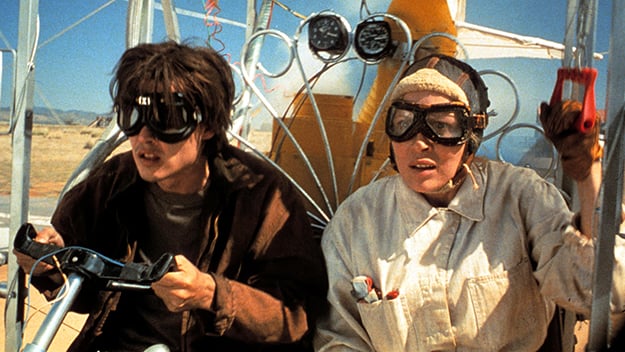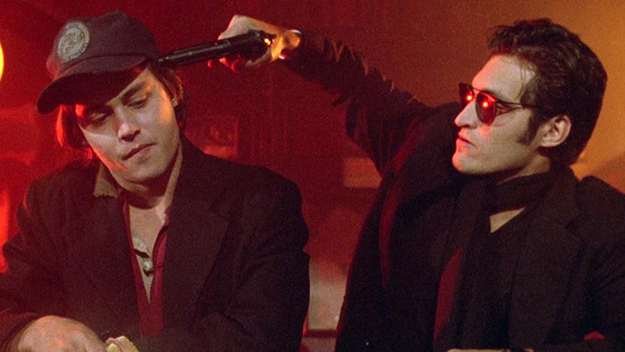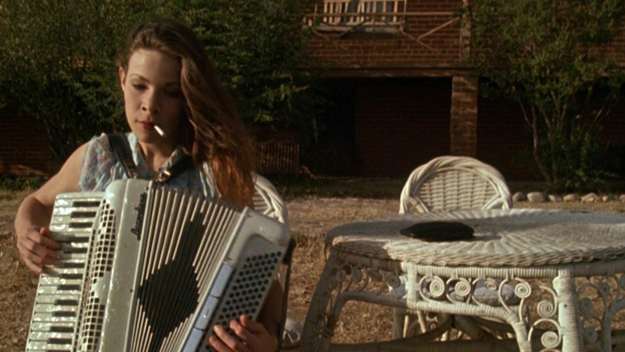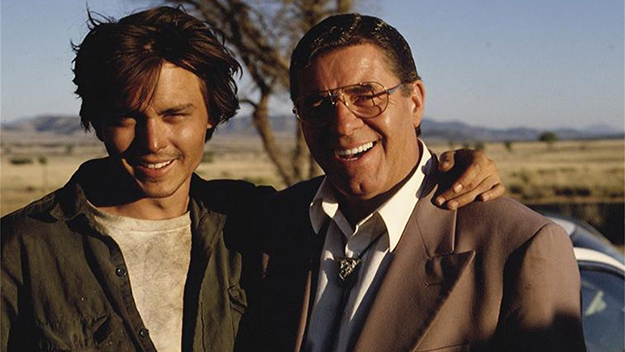Present Tense: Arizona Dream
Present Tense is a column by Sheila O’Malley that reflects on the intersections of film, literature, art, and culture.

Johnny Depp and Faye Dunaway in Arizona Dream (Emir Kusturica, 1993)
The first—and then second—time I saw Emir Kusturica’s Arizona Dream was January, 1995, during its week-long run at the Chicago Art Institute. A friend read an intriguing review of the film and we took the bus down and settled into the theater, trying to warm up after being out in the brutal winter. My friend and I were enraptured by the film’s heady blend of poignancy, hilarity, and magical realism, not to mention the performances from Faye Dunaway, Jerry Lewis, Johnny Depp, Lili Taylor, and Vincent Gallo. I asked my friend recently to confirm this memory and, even though he hasn’t seen the film since that day so many years ago, he mentioned two specific moments we had loved in particular. Back then, I had a prescient feeling that I wouldn’t have a chance to see Arizona Dream again, so I took the bus down to see it before it left the theater. Once again, the film captivated me with its weird vision, out-there humor, and emotion.
The original cut of Arizona Dream—the one I saw—was 142 minutes long. Even though the film won the Silver Bear at the 1993 Berlinale, Warner Brothers held off on releasing it in the United States. When the film finally made it to theaters in 1994, Warner Brothers had hacked out 23 minutes. Despite the presence of Hollywood legends in the cast as well as hot new actors, audiences didn’t go see it. I am one of a handful of people who saw the original cut, merely because the Chicago Art Institute decided to run it for a 5-day engagement in 1995. 16 years later, the film showed up on DVD but—unforgivably—it was the shorter cut. Unaware of this history at the time, I bought the DVD, and as I watched, I could tell the film had been butchered. Some of my favorite sequences had been removed (one involving Vincent Gallo’s movie-mad character getting onstage at a local showing of Raging Bull and performing both sides of the “You fucked my wife” scene, with Pesci and DeNiro looming behind him.) The film’s loopy rhythm had been destroyed. Subtleties had been excised. Critics reviewing the DVD were baffled, although many who knew the history yearned to see the lost footage. Others dismissed it, one critic bemoaning that Johnny Depp was ever in such a “turkey,” and criticizing the film’s thematic use of suicide. (One wonders how she would react to Harold and Maude. Arizona Dream has much in common with Hal Ashby’s films: there is a similar dreamlike mood, with near-somnambulists wandering through a dazed American landscape, littered with the detritus of capitalism, politics, ideals. If you think of the film as an heir to Harold and Maude or Shampoo, it helps contextualize it.) Warner Brothers’ handling of this delicate dream of a movie is part of its history. For years after, the full version of Arizona Dream lingered in my head, a shimmering mirage, a Holy Grail. I questioned my initial response. Could it have been that good?
I have found the Holy Grail at last: the full-length version has been uploaded to YouTube by a kind soul. And yes, it was that good.

Depp and Vincent Gallo in Arizona Dream (Emir Kusturica, 1993)
The plot of Arizona Dream is simple, although Kusturica’s treatment is not. A young aimless man named Axel Blackmar (Depp), working for New York’s Department of Fish and Game, is summoned back to Arizona by his childhood friend Paul (Gallo) to be the best man at the wedding of Axel’s uncle and childhood hero, a Cadillac salesman named Leo Sweetie (Lewis) to a woman 40 years his junior (Paulina Porizkova). While in Arizona, Axel meets Elaine Stalker (Dunaway), a glamorous kooky woman obsessed with building her own flying machine. He also meets Elaine’s gloomy stepdaughter Grace (Taylor), who spends her time smoking cigarettes, playing the accordion, and threatening suicide. Axel falls madly in love with Elaine, mirroring his uncle’s May-December relationship, and devotes himself to building her a flying machine. Kusturica comes at all of this from a surrealist and Jungian standpoint, which saves it from becoming “twee.” Here, the symbols filling our psyches and dream lives take corporeal form. What happens when people’s dreams collide? Different dreams should be able to co-exist. To quote a famous insomniac: Ay, there’s the rub.
With a screenplay by David Atkins, Arizona Dream was the first film by the Sarajevo-born director to take place in an American setting using American actors. Kusturica had made a couple of films in Europe, the second of which, When Father Was Away on Business, won the Palme d’Or. For Arizona Dream, Kusturica used many collaborators from Balkan countries: the cinematographer was Slovenian-born Vilko Filač, and Goran Bregović, also from Sarajevo, provided the music, including composing three songs performed by Iggy Pop, all of which have a minor-chord melancholy, but it’s melancholy with a jaunty mischievous step, a clue to the film’s tone. Arizona Dream is informed by Kusturica’s outsider stance: his vision of America is a place of neon cactuses, wide open spaces, yellow desert, giant moons, pink Cadillacs, just like the one Elvis—the ultimate American symbol—had. In one scene, it looks like Axel and Paul emerge from New York’s Lincoln Tunnel directly into the Arizona desert, as opposed to New Jersey. And maybe America feels that way from the outside. The symbols of America are mythic and poetic through the lens of a man who hails from an area burdened by history, a country crowded in by other countries (Arizona Dream was shot in 1991, just as war erupted in the former Yugoslavia.) In Arizona Dream’s America, the sky can’t be the limit because the sky itself is limitless.

Lili Taylor in Arizona Dream (Emir Kusturica, 1993)
The movie’s images have stuck in my head all these years: A rickety-winged machine in the desert, guarded by a husky dog with ice-blue eyes. A red balloon floating from the Bering Sea to Manhattan’s East River. Wobbly ceiling fans and Django Reinhardt records played on an old Victrola. Johnny Depp dancing with a chair as Lili Taylor washes dishes, smoldering at him with fury and desire. Jerry Lewis running around in a pink tuxedo, bolo tie, and white cowboy boots. A tree bursting into flames. Vincent Gallo re-enacting the cropdusting scene in North by Northwest for a baffled crowd at an open mic night. A fish floating through the sky. And, rich with significance: A “Cadillac graveyard” in the middle of the desert, a line of pink cars hovering on stilts, with Jerry Lewis dancing beneath them, swinging a broom in the sunset-lit dust.
Each character dreams of a different thing. Axel dreams of Alaska and a fish flying through the air. Leo dreams of Cadillacs stacked so high they reach the moon. Elaine dreams of flying machines and Papua New Guinea. Grace dreams of suicide and turtles. Paul dreams of being a 1970s movie star with a New York accent. At times, these characters’ dream-worlds are so impenetrable they are unreachable to one another. But when they enter each others’ dreams, catastrophe and/or transcendence is the result. Axel’s fish flies over Elaine’s flying machine, which promptly crumbles into pieces. Grace’s turtle sinks beneath the ice in the Bering Sea. In one unforgettable scene, Paul finds himself re-enacting the cropdusting scene for real, when Elaine, finally airborne in the machine built for her by her young lover, dive-bombs him from above. In one of the most memorable scenes, Axel, Grace, Paul and Elaine eat dinner, talking simultaneously, playing multiple games of footsie underneath the table. In the chaos, everyone’s dreams erupt to the surface: Elaine won’t stop babbling about Papua New Guinea even though Grace begs her to stop. Grace sets her pet turtles free and then tries to commit suicide by hanging herself with her pantyhose (it doesn’t go well). Paul, bonked on the head by the whirling ceiling fan, quotes in full the Cowardly Lion’s lines from Wizard of Oz. The scene is a raucous delirious madhouse. (Faye Dunaway visited one of my acting classes once. Students asked her about Chinatown, Bonnie and Clyde, Network. I asked her about the dinner scene in Arizona Dream, and whether or not it was improvised. She could not believe I had even seen the film, and literally squealed and clapped her hands in excitement that someone remembered it. She said no, none of it was improvised, which makes the scene even more extraordinary.)

Johnny Depp and Faye Dunaway in Arizona Dream (Emir Kusturica, 1993)
Arizona Dream allows these actors to use muscles they aren’t often asked to use. Faye Dunaway is screwball hilarious. In her only scene with Jerry Lewis, she keeps calling him “Mr. Smiley,” even though he reminds her repeatedly his last name is “Sweetie.” Watching Dunaway run around in the desert, flapping her arms with enormous wings attached to them, is worth the price of admission. Arizona Dream was filmed the same year as Nancy Savoca’s Dogfight, where Lili Taylor was plump and earnest; here she is all sinewy muscle, all rage, and so tough that when she softens you worry for her. Jerry Lewis gets to do his schtick, which is very satisfying, but he also gets to be tender and pained. And Depp glows. He’s the ingenue here. He’s fanciful, unpredictable. Vincent Gallo gives his best performance here. He makes a humorless character funny. There’s also his spookily-accurate imitation of Cary Grant’s various postures of alarm in the cropdusting scene (this was one of the scenes my friend mentioned when I asked him about seeing the film so long ago).
Where we stand now: Arizona Dream is on Amazon Prime, but only the edited version. The DVD is available, but only the edited version. I don’t recommend seeing the edited version, unless you take into consideration that the film was destroyed. Occasionally the unedited version shows up on YouTube. It’s there now. See it while you can.

Johnny Depp and Jerry Lewis in Arizona Dream (Emir Kusturica, 1993)
I compared the two versions, and discovered that, along with all the lost texture and humor, most catastrophically, a scene where the theme is stated outright by Depp has been removed. In a surrealist film, the theme can be helpful in orienting an audience. On a sleepless night, where it’s not clear what’s dream and what’s reality, Axel ruminates:
“Whenever I try to remember my dreams, I always turn them into stories. Dreams are like light. You can’t catch them with your hands because you can’t catch something you don’t really see… Being caught in a dream of two women is the craziest storm you’ll ever find yourself in, and the battle is never a fight of good and evil, but between weaker and stronger, and the weaker is always desperate for air. At this moment my feet were planted in the ground like a tree. And if you move to one side, you become the storm. And even though I was ready to kill Grace, I wasn’t sure which side of the storm I’d move to, so I tried to anchor myself until the storm passed.”
In his sensitive review at Slant of the DVD release, Bill Weber summed up the situation: “Someday this fascinating curio by a major European filmmaker will get its full due.”
Sheila O’Malley is a regular film critic for Rogerebert.com and other outlets including The Criterion Collection. Her blog is The Sheila Variations.







